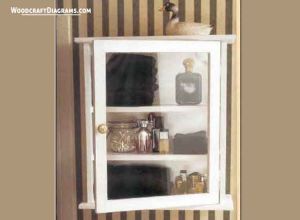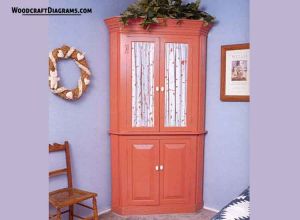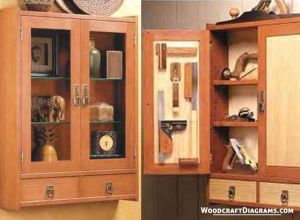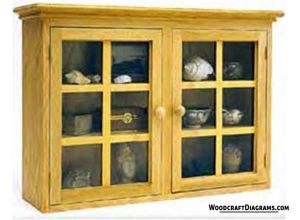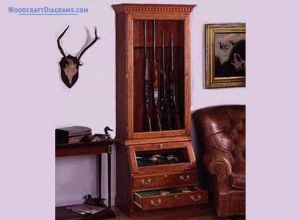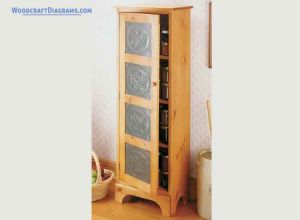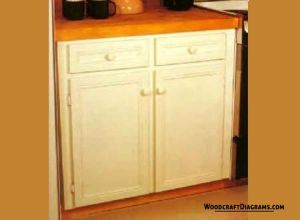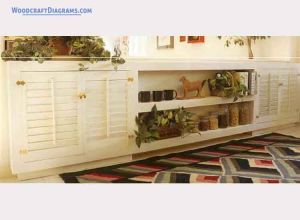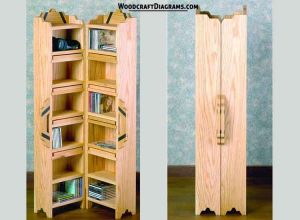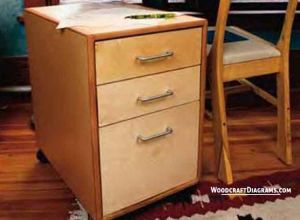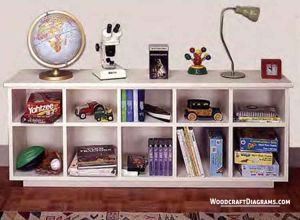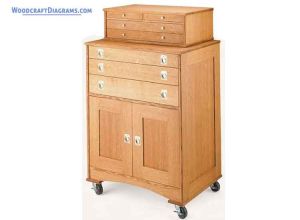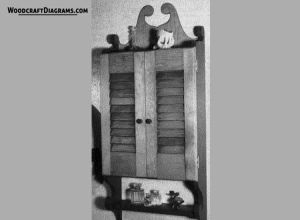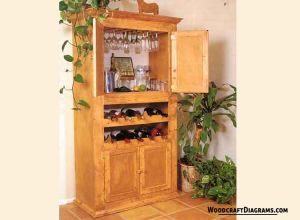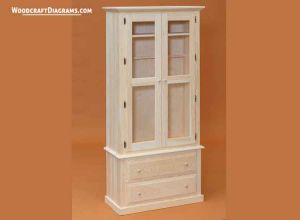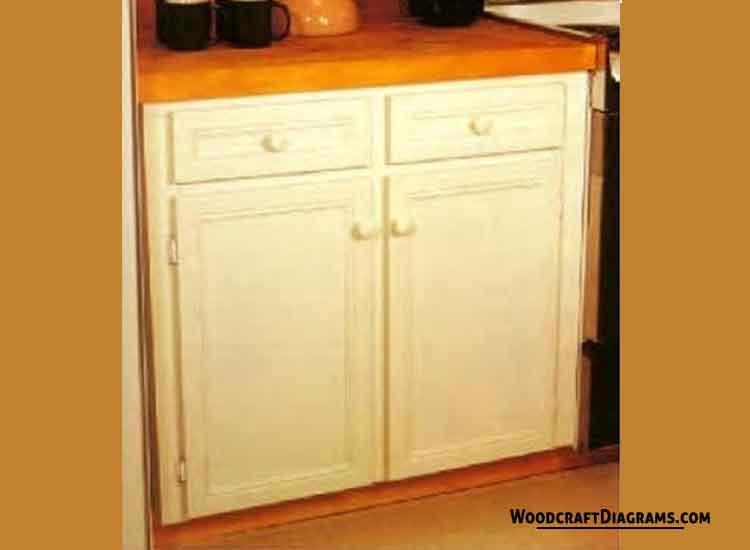
These kitchen storage cabinet plans and blueprints can be used to create a beautiful pine case that will keep its contents safe and dry.
It has two large drawers on top, extra storage room at bottom, and a wooden countertop.
You can put it against a wall, or use it as a free-standing structure.
Details For Constructing the Cabinet Frame
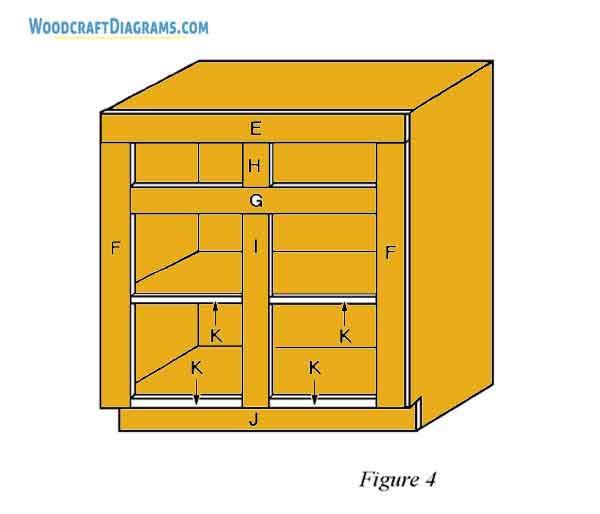
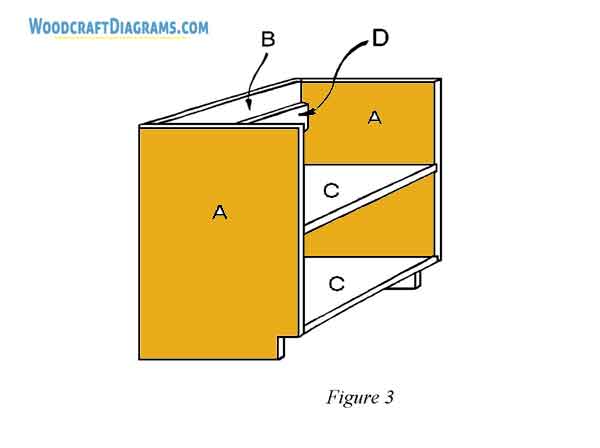
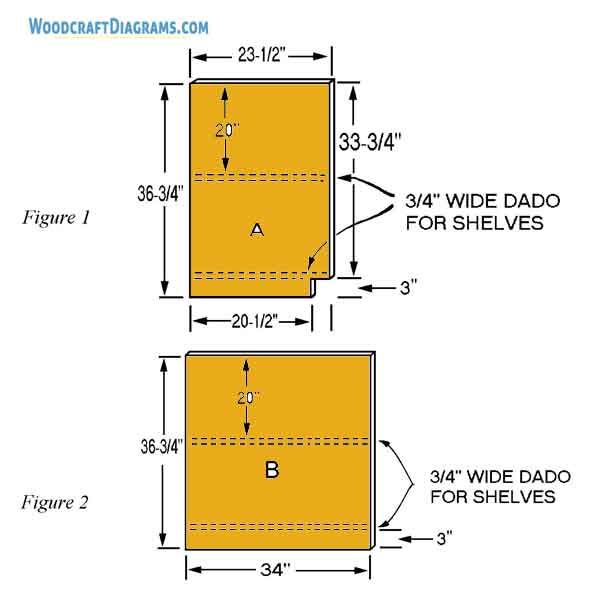
Cut two cabinet sides (A) from ¾”-thick plywood according to the dimensions given in Figure 1 2.
Cut one cabinet back (B) from ¾”-thick plywood according to the dimensions given in Figure 2.
Cut two cabinet shelves (C) from ¾”-thick plywood, each measuring 23 x 34-1/2”.
Inspect each face of the two cabinet sides (A), and choose the better ones to face outward on the finished cabinet.
On the inner faces of the two cabinet sides (A) and the cabinet back (B), cut two dadoes, each ¾”-wide and ¼” deep, at the heights indicated in Figures 1 and 2.
These provide support for the shelves (C).
Assemble the two sides (A), back (B), and two shelves (C), as shown in Figure 3.
Note that the shelves (C), slide into the dadoes.
Check to make sure that all of the parts are square and level.
Use glue and 3-penny finishing nails spaced about 5 inches apart to secure the pieces together, and fasten a web clamp around the assembly for added strength.
Leave the cabinet clamped overnight.
(If you are unsure about how to use clamps for this assembly, consult “Tips and Techniques” on our home page.
Cut one 34”-long back support (D) from 1 x 4 pine.
Measure and draw a line 4 inches down from the top across the cabinet back (B).
Nail and glue the back support (D) to both sides (A) and to the back (B).
Place one nail every 6 inches.
This strengthens the cabinet and is used later to brace the metal drawer glides that support the drawers.
Adding the Rails and Stiles
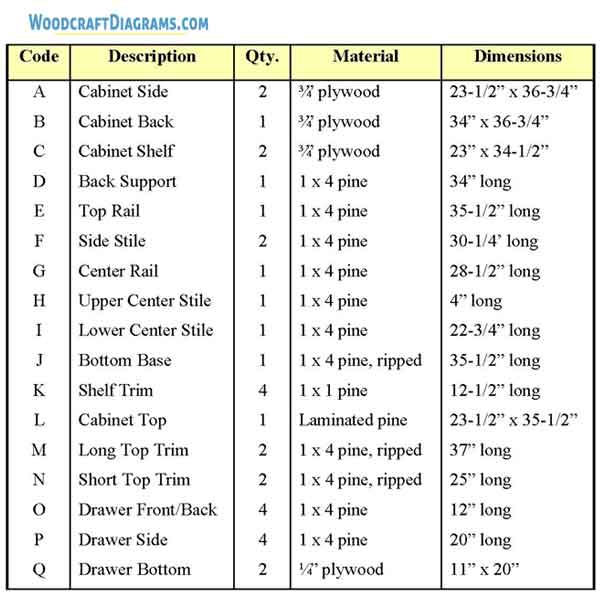
The front of the cabinet consists of rails (horizontal members) ad stiles (vertical members).
These members fulfill two functions: they support the cabinet doors, and they form the finished front.
A diagram of their placement is shown in Figure 4.
It is very important that you install each of the stiles and rails so that they are all exactly square, or your drawers and cabinet doors will not fit properly.
Cut one 35-1/2”-long top rail (E) from 1 x 4 pine.
Using glue and two finishing nails on each end, attach the top rail (E) flush with the top edges of the cabinet sides (A), as shown in Figure 4.
Cut two side stiles (F) from 1 x 4 pine, each 30-1/4” long, and attach them to the cabinet sides (A) below the top rail (E).
Use glue and 3-penny finishing nails, spacing the nails about 6 inches apart.
As shown in Figure 4, the stiles should be flush with the outer edges.
Cut one 28-1/2”-long center rail (G) from 1 x 4 pine, and attach it 4 inches below the top rail (E), between the two side stiles (F).
After applying glue, toenail the center rail (G) into the side stiles (F) using two finishing nails on each end.
From 1 x 4 pine, cut one 4—long upper center stile (H) and one 22-3/4”-long lower center stile (I).
Attach the upper center stile (H) between the top rail (E) and the center rail (G), as shown in Figure 4.
Apply glue, and toenail the center stile (H) into the top rail (E) and the center tail (G), placing two finishing nails at each end.
The lower center stile (I) is attached to each of the shelves (C).
Make certain that both of the shelves (C) are perfectly level in the center.
Use glue and two finishing nails to attach the lower center stile (I) to each of the shelves (C).
Glue and toenail the lower center stile (I) to the center rail (G).
Cut a 35-1/2” length of 1 x 4 pine.
Rip the length to 3 inches in width, and attach the resulting bottom base piece (J) across the bottom edge of the assembled cabinet so that it covers the raw, bottom edges of the cabinet sides (A), as shown in Figure 4.
To secure the attachment, first glue all of the exposed joints.
Then use two 3-penny finishing nails to toenail the bottom base piece (J) to the lower center stile (H).
Next, with two finishing nails on each end, attach the bottom base piece (J) to the edges of the cabinet sides (A).
Finally, nail through the lower cabinet shelf (C) into the bottom base piece with finishing nails placed about 6 inches part.
Cut four shelf trim pieces (K) from 1 x pine, each 12-1/2” long.
Use glue and finishing nails placed every 6 inches to attach the shelf trim (K) to the exposed fronts of each of the shelves (C) between the stiles (F and I).
Making the Top
If you purchased material already laminated, trim the piece to 23-1/2 x 35-1/2 inches to make the cabinet top (L).
Then skip down to Step 4.
To do the lamination yourself cut seven lengths of 1 x 4 pine, each 35-1/2” long.
Before gluing the wood lengths together, it is a good idea to rip a minuscule amount from each edge to ensure a solid bond in the lamination process.
Then spread glue on the adjoining edges, and place the lengths of wood side by side.
Clamp them together securely, using at least two bar clamps, and leave them clamped overnight.
Trim the completed top (L) to 23-1/2” x 35-1/2” by ripping ½” from each 35-1/2” long edge.
Set the top (L) onto the cabinet assembly flush with all four of the cabinet’s outer edges.
Use glue and finishing nails, placing the nails about every 6 inches, to attach the top (L) to the cabinet.
Rip 11 feet of 1 x 4 pine to a width of 2 inches.
The resulting material is used to trim the cabinet top (L).
From the 2-inch material, cut two long top trim pieces (M), each 37 inches long, and two short top trim pieces (N), each 25 inches long.
Setting each piece on its 2-inch face, miter both ends of all four top trim pieces (M and N) at a 45-degree angle.
Glue and nail the short trim pieces (N) to the edges of the laminated cabinet top (L) using 3-penny finishing nails spaced about 6 inches apart.
Glue and nail the long rim pieces (M) to the front and back of the laminated cabinet top (L).
Use finishing nails placed about every 6 inches, and countersink all of the nails.
Making the Drawers
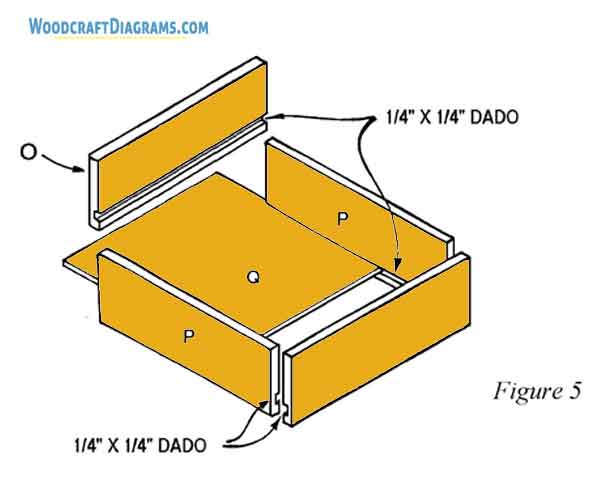
There are two identical drawers in this cabinet.
Both are constructed as shown in the assembly diagram in Figure 5.
Cut the following parts for the drawer from 1 x 4 pine: two drawer front/back pieces (O), each 12 inches long, and two drawer sides (P), each 20 inches long.
Cut a ¼” by ¼” dado on the inside of each drawer piece (O and P), 3/8” from the lower edge, to accommodate the plywood bottom.
Cut one 11” x 20” drawer bottom (Q) from ¼”-thick plywood.
Assemble the drawer as shown in Figure 5.
Use glue and finishing nails, pacing two nails on each end of the overlapping boards.
The drawer front is added later.
Repeat Steps 1 through 3 to build a second drawer.
Making the Drawer Fronts
If you purchased your drawer fronts and cabinet doors, skip down to the “Installing the Hardware,” below.
These instructions describe how to make your own, starting with the construction of the drawer fronts.
Although they have different dimensions the drawer fronts and cabinet doors are built in exactly the same manner.
The drawer front is nothing more than a center panel of ¼” plywood that is inserted into a 1 x 2 frame, and trimmed with decorative molding (Figure 6).
It’s not difficult to do, but it requires a certain amount of precision when cutting to obtain a professional-looking finished product.
Don’t hurry the process, and be meticulous in your work.
Cut one 10-1/2” x 2” drawer panel (R) from ¼” thick plywood.
Cut two drawer top/bottom frame pieces (S) from 1 x 2 pine, each 10” long.
Cut two drawer side frame pieces (T) from 1 x 2 pine, each 5 inches long.
Cut a ¼” x ¼” dado along the inside edges of each of the frame pieces (S and T) to accommodate the drawer panel (R).
A cutting diagram is shown in Figure 6.
Place the drawer panel (R) into the dadoes cut into the frame pieces (S and T).
Glue and clamp, then nail the frame pieces together.
Use two 3-penny finishing nails on each end of the overlapping boards.
Allowing a little extra length for the miters, cut four pieces of ¼”-thick decorative molding to fit around the inside edges of the frame.
Set the molding so that the decorative edge faces up, and miter both ends of each piece at a 45-degree angle.
Attach the mitered pieces to the plywood panel with glue and wire brads.
Countersink the brads.
Repeat Steps 1 through 6 to assembly the second drawer front.
Making the Cabinet Doors
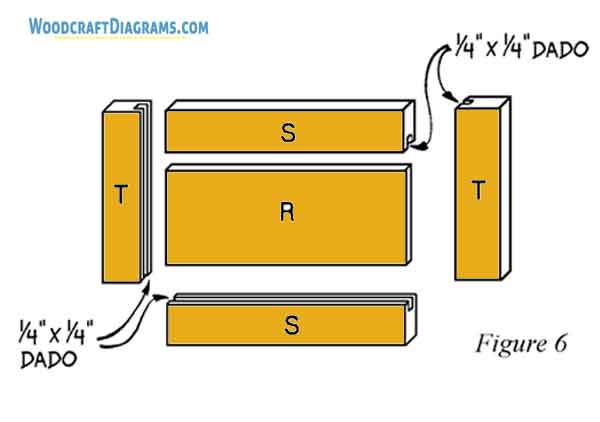
The cabinet doors are constructed using the same procedures that you followed for the drawer fronts.
The only difference is the size of the parts.
To make one cabinet door, cut one 10-1/2” x 21” panel (R2) from ¼”-thick plywood.
Cut two cabinet top/bottom frame pieces (S2) from 1 x 2 pine, each 10” long.
Cut two cabinet side frame pieces (T2) from 1 x 2 pine, each 21 inches long.
To construct the cabinet doors, follow steps 1 through 7 (substituting R2, S2, and T2 for R, S, and T) in the previous section, “Making the Drawer Fronts.” Installing the Hardware 1.
Following the manufacturer’s instructions to install the metal drawer glide between the back support (D), and the center rail (G).
Install a roller on the bottom of each drawer, and on the inside of the center rail (G), again following the manufacturer’’ instructions.
Installing the Doors and Drawer Fronts
The easiest method is to attach the drawer fronts first.
For the job to look very professional, all of the drawers and doors must be exactly straight and level.
Set the assembled drawers inside the drawer opening on the cabinet, placing them on the metal drawer glides.
Place a scrap piece of wood between the back of each drawer and the back of the cabinet so that the drawers are held flush with the front of the cabinet.
Use heavy-duty, double-sided tape to hold a drawer front temporarily in place on each drawer until you have both drawer fronts positioned exactly right.
Then attach the fronts to the drawers.
Use two finishing nails driven from the inside of the drawer into the drawer top frame (S), and two finishing nails driven into the drawer bottom frame (S).
Measure carefully, and install the hinges on each of the doors.
The hinges should be positioned the same distance from the top and bottom of each door.
Have someone help you support the doors, and hold the doors with the attached hinges over the door opening.
Line up each door so that its width is exactly even with the width of the drawer above it, and make sure both doors are at an even height with each other.
Then screw the remaining sides of the hinges to the cabinet.
Attach the drawer pulls on each of the drawers on the cabinet doors.
The pulls should be evenly spaced and aligned with one another.
Finishing
Countersink all of the nails, and fill the resulting holes with wood filler.
Sand every surface thoroughly.
Paint or stain the completed cabinet the color of your choice.
For the cabinet in the photograph, I stained the laminated top and painted the remainder of the cabinet white.
To customize your cabinet, you can add wood molding at the base to match the existing molding in your kitchen.
If the cabinet is to be a free-standing island, you may wish to add base molding on all four sides.



